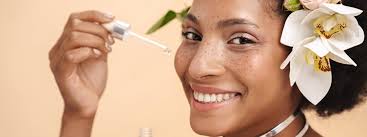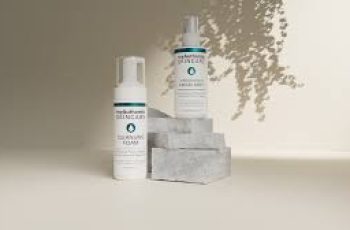
How To Use Salicylic Acid?
If you find yourself with an oily and blemish-prone skin type, chances are you’ve been recommended a product or range of products containing salicylic acid. One of the most used BHAs, you’ll find salicylic acid is a highly effective, but potent ingredient that can make light work of the build-up of dead skin cells, bacteria, dirt, debris, and other impurities, all of which if left on the skin will result in frequent breakouts, spots, and blemishes.
Compared to its cousins, such as glycolic acid and lactic acid, the molecular size of salicylic acid is very small meaning it can penetrate further into the skin. It is also oil-soluble making it an easy task to cut through any excess sebum. This does, however, come with some side effects as it overused, or used incorrectly can strip the skin of the vital oil it needs to remain balanced and healthy. Is it why those who are dry, or prone to severe sensitivity should avoid using salicylic acid in their daily skincare routine.
There you have a brief introduction to how salicylic acid works on the skin, but if you wanted to find out more check out our dedicated about the skincare benefits of salicylic acid. Now let’s move onto finding out more about how to use salicylic acid.
What is the best way to use salicylic acid?
This depends on your routine and how you can work salicylic acid into it. You’ll find that salicylic acid is formulated into an array of skincare products, from face cleansers to overnight serums. Whichever you decide to include in your routine, you must first take into consideration your skin type, your skin concerns, and your already established skincare routine.
Face Cleansers & Face Wash
These often contain the lowest percentage of salicylic acid meaning they are an effective product to use every day to help combat build-up of excess oil, dirt, and bacteria. They are also a good product to start with if you are new to salicylic acid as they are rinsed from the skin meaning they don’t remain on the face for too long, meaning you are able to avoid irritation or dryness.
Exfoliating Toners
The benefit of using an exfoliating toner after cleansing is the fact you can rid any remaining traces of dead skin cells, debris, and impurities leaving you with a glowing, vibrant, and healthy-looking complexion. Many find that exfoliating toners are the most effective and easiest product to include into their routine.
Serums and Moisturisers
Serums and moisturisers contain the highest concentrate of salicylic acid so are often favoured by those who want fast results and how already built their skin’s tolerance to the acid. With salicylic acid often causing the skin to have increased photosensitivity it is best to use your BHA enriched serum and moisturisers during your evening routine. You should then follow this with a SPF of 30 and above in your morning routine for added UV skin protection.
You can also book in you’re a professional chemical peel in an established spa or salon. This will contain medical grade salicylic acid which is the most potent form of BHA you will find compared to over-the-counter formulas. This is a great option for anyone who has a few different skin concerns and wishes to target them all effectively with one treatment.
Much like all skincare products I would always suggest you consult with a doctor or dermatologist to ensure salicylic acid will benefit you and your skin whilst avoiding unwanted reactions.
How long leave salicylic acid on face?
As I have just mentioned, this depends on the formula and product you use containing salicylic acid. Bear in mind the BHA can cause severe dryness, itching, and irritation for the skin it’s considered best to start with face cleansers and exfoliating toners to build your skin’s tolerance. Once your skin is used to salicylic acid you can move onto more potent formulas, such as serums and moisturisers.
Whichever you choose it is best to perform a patch test for 24 hours before applying any product all over the skin. This will give you the best idea of whether your skin will benefit from the product or suffer from any irritation.
How is salicylic acid used in a routine?
Salicylic acid can be used in many ways in your routine, as you now understand, cleansers and toners are the considered the easiest to introduce the acid into your routine. For oilier and blemish prone skin types, they may find that using serums deliver more desirable, faster results.
If you wanted to know more about how to add salicylic acid to your routine, you can check out our dedicated blog post about howe to introduce a salicylic acid serum into your routine.
How do you use salicylic acid every day?
You can use salicylic acid twice a day if by using cleanser or toners as they are the gentlest formulations. For more potent products you can apply them every day, but only after you have established your skin will be happy with this.
With such a potent ingredient such as salicylic acid, it is best to not overuse any product containing the BHA as the oil can be stripped from the skin. This will not only result in your skin feeling tight, uncomfortable, or itchy, but you will also find there is a flare-up in spots and blemishes. The skin barrier will also become weakened which will lead to more damage, such as dark spots, hyperpigmentation, fine lines, wrinkles, and loss of elasticity.
Do you need to wash off salicylic acid?
No, not necessarily as it depends on the salicylic acid product you use. Serums, for example are considered best to remain on the face for the longest time possible meaning they are a great product to use in the evening. This results in the skin benefitting from the BHA whilst you catch up on your beauty sleep leaving you with a healthy complexion come the morning.
There you have a little more information about how to use salicylic acid, don’t forget if you have any more skincare questions, come, and follow us on Instagram.


